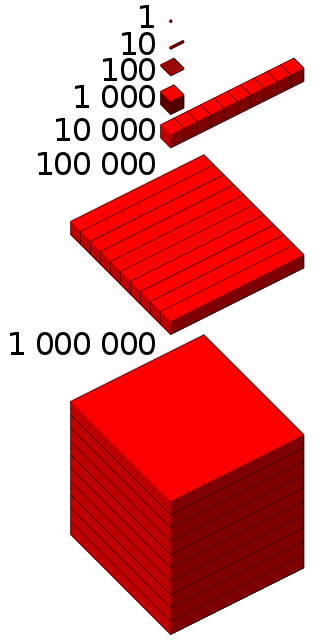Related Research Articles
10 (ten) is the even natural number following 9 and preceding 11. Ten is the base of the decimal numeral system, the most common system of denoting numbers in both spoken and written language.
34 (thirty-four) is the natural number following 33 and preceding 35.
1000 or one thousand is the natural number following 999 and preceding 1001. In most English-speaking countries, it can be written with or without a comma or sometimes a period separating the thousands digit: 1,000.
300 is the natural number following 299 and preceding 301.
127 is the natural number following 126 and preceding 128. It is also a prime number.
700 is the natural number following 699 and preceding 701.
800 is the natural number following 799 and preceding 801.
900 is the natural number following 899 and preceding 901. It is the square of 30 and the sum of Euler's totient function for the first 54 positive integers. In base 10, it is a Harshad number. It is also the first number to be the square of a sphenic number.
It is:
4000 is the natural number following 3999 and preceding 4001. It is a decagonal number.
6000 is the natural number following 5999 and preceding 6001.

1,000,000, or one thousand thousand, is the natural number following 999,999 and preceding 1,000,001. The word is derived from the early Italian millione, from mille, "thousand", plus the augmentative suffix -one.

1,000,000,000 is the natural number following 999,999,999 and preceding 1,000,000,001. With a number, "billion" can be abbreviated as b, bil or bn.
100,000 (one hundred thousand) is the natural number following 99,999 and preceding 100,001. In scientific notation, it is written as 105.
194 is the natural number following 193 and preceding 195.
10,000,000 is the natural number following 9,999,999 and preceding 10,000,001.
251 is the natural number between 250 and 252. It is also a prime number.
20,000 is the natural number that comes after 19,999 and before 20,001.
40,000 is the natural number that comes after 39,999 and before 40,001. It is the square of 200.
60,000 is the natural number that comes after 59,999 and before 60,001. It is a round number. It is the value of (75025).
References
- ↑ Sloane, N. J. A. (ed.). "SequenceA001632(Smallest prime p such that there is a gap of 2n between p and previous prime)". The On-Line Encyclopedia of Integer Sequences . OEIS Foundation.
- ↑ Metsänkylä, Tauno (1976). "Distribution of irregular prime numbers". Journal für die Reine und Angewandte Mathematik . 1976 (282): 126–130. doi:10.1515/crll.1976.282.126. MR 0399014. S2CID 201061944.
- ↑ Sloane, N. J. A. (ed.). "SequenceA006285(Odd numbers not of form p + 2^k (de Polignac numbers))". The On-Line Encyclopedia of Integer Sequences . OEIS Foundation.
- ↑ Sloane, N. J. A. (ed.). "SequenceA071331(Numbers having no decomposition into a sum of two prime powers)". The On-Line Encyclopedia of Integer Sequences . OEIS Foundation.
- ↑ Schoen, Robert (1984). "Harmonic, geometric, and arithmetic means in generalized Fibonacci sequences" (PDF). The Fibonacci Quarterly . 22 (4): 354–357. MR 0766313.
- ↑ Sloane, N. J. A. (ed.). "SequenceA000328(Number of points of norm ≤ n^2 in square lattice)". The On-Line Encyclopedia of Integer Sequences . OEIS Foundation.
- ↑ Sloane, N. J. A. (ed.). "SequenceA051567". The On-Line Encyclopedia of Integer Sequences . OEIS Foundation.
- ↑ Sloane, N. J. A. (ed.). "SequenceA002050(Number of simplices in barycentric subdivision of n-simplex)". The On-Line Encyclopedia of Integer Sequences . OEIS Foundation.